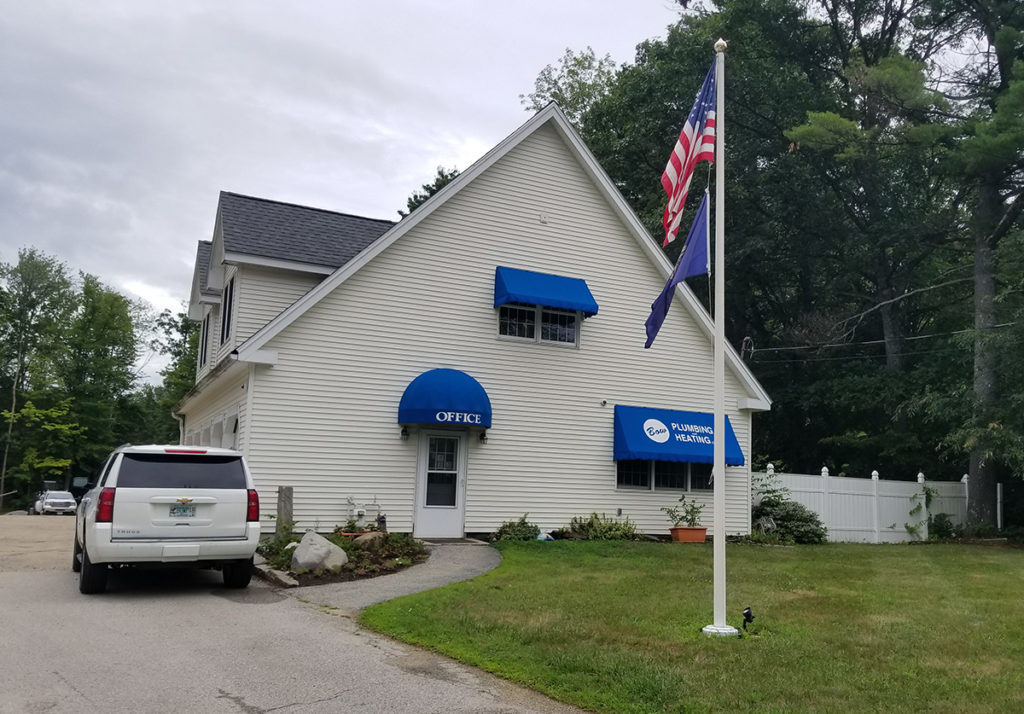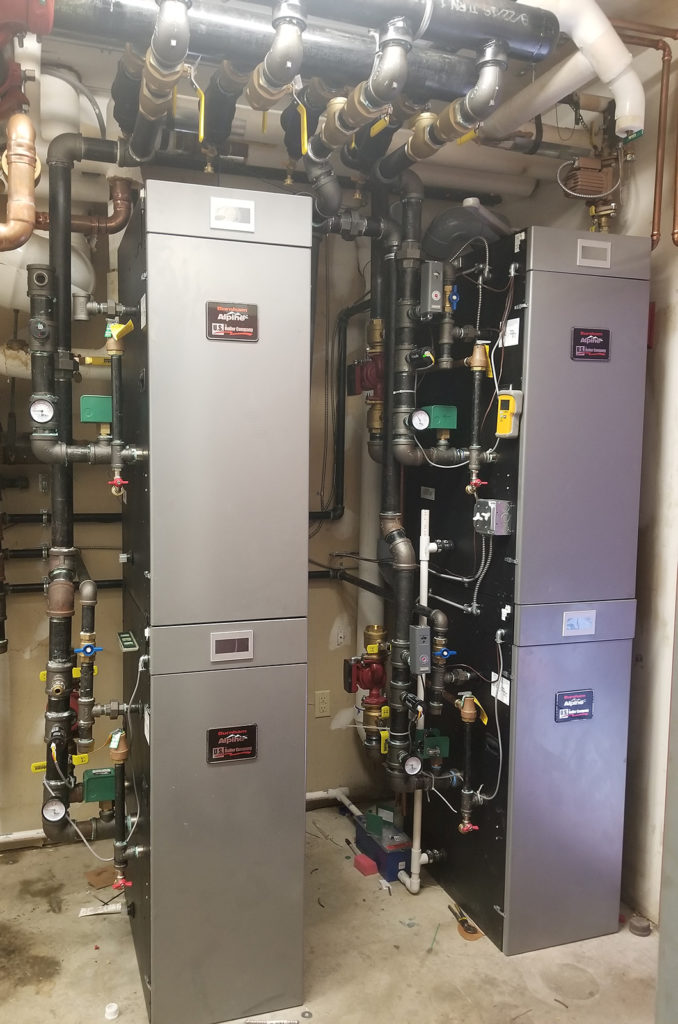Some HVAC companies focus exclusively on home comfort. Others concentrate on commercial work. And then there are those that operate effectively in both markets.
Bob Ives, president of Bow Plumbing and Heating Corp. in Bow, New Hampshire, explains that they specialize in home comfort, but their frequent high-efficiency boiler work makes his company a name to know in the commercial boiler realm, too.
“In addition to plumbing and forced-air systems, we do a lot of boiler swap-outs, somewhere in the neighborhood of 30 units each year,” he said. We’re even busy with boiler work throughout the summer months. And once or twice each year, we’ll find ourselves retrofitting a large commercial boiler system.”
The 8-person company was founded Bob’s father in 1960, and is now in its third generation, includes his sons Eric (38), Timothy (34), and his daughter Christina (30). Bob’s wife, Joanne, runs the office, and grandkids Conner and Jocelyn sweep floors and generally help around the shop. Bob took over in 1972, and the company serves the greater Concord, NH area.

Above: Bow Plumbing and Heating Corp. is an eight person company serving the greater Concord, NH area.
“There are two big challenges in our area as it relates to installing condensing boilers, and I think installers up and down the east coast would probably share the same woes,” said Bob. “Getting the old boilers out of a cramped basement is the first issue. We break them down and haul them out one piece at a time. The second challenge is convincing homeowners that they’ll see a payback, and that it often comes quickly. To overcome this challenge, we have documented energy use improvements, and a host of testimonials to back them up.”
Putting past successes to work during the sale of a system isn’t just a good approach in residential situations, either. Bow P&H has a reputation in their area for being a great solution provider at public facilities.
School retrofits
A number of years ago, Bow P&H replaced the boiler system at Loudon Elementary, one of the facilities in the Merrimack Valley School District. That oil-to-gas conversion, with four new Alpine boilers installed in place of the existing five oil boilers, yielded major improvements.
“Energy expenses fell by $15,000 dollars the first year, and annual maintenance costs were reduced by $1,000,” said Neil Barry, recently retired plant manager for the school district. “So when it came time to time to install new boilers at another school building early in 2017, I knew that Bow P&H already had a recipe for success.”
Boscawen Elementary School is about 25 years old, and holds about 500 students. The big existing boiler was still serviceable, but fuel costs were more than the district wanted to budget. The connected load is comprised of fin-tube baseboard and fan coil units that serve common areas. In addition, the building needed a new DHW system.
Making it fit
“After visiting the school, we knew we’d be dealing with a space constraint,” explained Ives. “The old boiler was to remain in place for complete redundancy, and the mechanical space was already pretty tight. As part of the bid process, we had to figure out how to make the new and old systems both fit in the room.”
The mechanical room is long and narrow, with the old boiler taking up the back one-third of the space. Four, 399 BTU Alpine Commercial boilers would be stacked to the right of the entrance door. Ives also planned to install two new, 120-gallon indirect-fired water heaters between the new and old boilers. A building-wide domestic hot water recirculation systems was installed as well.
“Once it was decided to use condensing boilers, the decision was easy,” said Ives. “We’ve installed the U.S. Boiler Alpine for a long time, and this job wasn’t an exception. Installing an Alpine is like screwing in a light bulb. We fire them up, set the controls, walk away, and they perform like we want them to.”
With plenty of pre-planning, everything fit in the room on paper. Because of the cramped space, some components were pre-fabricated back at the shop. Eric Ives, Spencer Haywood, and Chris Smykil conducted most of the installation. The new boilers were tied together on a large injection loop that joins the existing hydronic piping.

Above: Boscawen Elementary School is now heated with four, 399 MBH Alpine Commercial boilers which have yielded a 33% energy savings during the first heating season!
The units are stacked two-high to conserve space, and a cat 5 cable runs from one unit to the next to provide cascading operation. Through the master controller, the boilers alternate lead-lag. This ensures that all units have approximately the same runtime hours, making service simple.
“The first time we installed the Alpine in a multiple-unit system like this, we spent some time on the phone with tech service,” said Ives. “U.S. Boiler support staff is known to go above and beyond, and now we don’t need any help on start-up.”
Lots of flexibility
“The Alpine Commercial provides up to 97% AFUE, but on a job like this, the real savings comes from the ability to drastically modulate input,” explained Ives. “We design our systems for a -20°F outdoor temp. It’s important to have that capacity, but we rarely see the mercury that low. Modulation is the answer, and the Alpine delivers.”
Barry agrees. Based on his energy tracking, the biggest difference in fuel consumption from a single, large boiler and multiple smaller boilers is realized in late fall and early spring, when buildings require partial heating capacity. This is when the ability to modulate is so critical.
“Over the past five or six years, we’ve grown so used to Alpines in residential sizes,” said Ives. “There’s a huge benefit in having the ability to install the Alpine Commercial in sizes from 399 to 800 MBH. There’s simply no learning curve.”
The mechanical room at Boscowen elementary is on the back side of the building, so the big boilers were vented with concentric kits after core drilling the building’s block wall. During the retrofit, Barry removed the existing pneumatic controls from the boiler room and replaced them with a new digital system. The work at the school wrapped up in one week, and savings started adding up as soon as school was back in session after the summer.
The winter of 2017-2018 quickly showed that the retrofit was a good idea. Barry documented a 33% fuel savings that stemmed directly from the retrofit, and the district is already budgeting for a large oil to gas conversion at another elementary school nearby.
“Before I retired, I had my choice of many different contractors large and small, local, state-wide and nation-wide,” said Barry “I’ve found that with Bow P&H – being small, independent and family owned – they’re more responsive and better understand my needs. They build personal relationships, and all their employees carry that same attitude through everything they do. It’s the reason I’m quick to recommend them to a variety of commercial facilities.”

